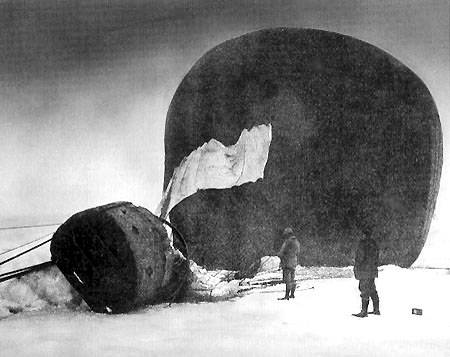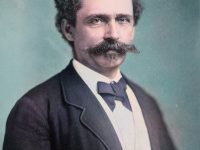
The balloon Örnen (The Eagle) along with Salomon Auguste Andrée and Knut Frænkel shortly after its descent onto pack ice. Photographed by Nils Strindberg.
On October 18, 1854, Swedish engineer, physicist, aeronaut and polar explorer Salomon August Andrée was born. Andrée died while leading an attempt to reach the Geographic North Pole by hydrogen balloon. The balloon expedition was unsuccessful in reaching the Pole and resulted in the deaths of all three of its participants.
Introducing Auguste Andrèe
Salomon Auguste Andrée attended the Royal Institute of Technology in Stockholm, graduating with a degree in mechanical engineering in 1874. Two years later he went to the Centennial Exposition in Philadelphia, where he was employed as a janitor at the Swedish Pavilion. In the United States, Andrée met the balloonist John Wise which highly influenced his further career. Andrée was occupied as an assistant at the Royal Institute of Technology in the early 1880s and later participated in a Swedish scientific expedition to Spitsbergen led by Nils Ekholm. There, Andrée was responsible for the observations regarding air electricity. During the next decade, he published scientific journals about air electricity, conduction of heat, and inventions.

Salomon August Andrée (1854-1897)
Becoming a Polar Explorer
The second half of the 19th century is often referred to as the heroic period of polar voyages. The inhospitable zones around the North and South Poles were a challenge for courage and technical achievements. Andrée’s plans for a balloon trip to the North Pole therefore fit in with the spirit of his time. He wanted to take off with his balloon from Svalbard and then travel across the Arctic Ocean to the Bering Strait to land either in Alaska, Canada or Russia. He wanted to cross the North Pole or pass it as close as possible.
A Manoeuvrable Balloon
In 1893 Andrée bought a hydrogen balloon, christened it Svea and made nine journeys via Sweden starting in Gothenburg or Stockholm, covering a total of 1500 kilometres. The longest journey went from Gothenburg via the Swedish mainland and the Baltic Sea to the island of Gotland. During some of the trips, he tested the tow lines he had invented himself, with which he wanted to steer the balloon in the future. As long as a balloon has the same speed as the wind, it is not possible to steer it with sails. The task of the towing lines was to reduce the speed of the balloon in order to make it manoeuvrable. However, since Andrée was the first Swedish balloonist, there was nobody in the country who had enough knowledge to check Andrée’s statements about tow lines and buoyancy.
A Swedish Polar Expedition
In his attempt to reach the North Pole by hydrogen balloon he was supported by the Royal Swedish Academy of Sciences and funded by people like King Oscar II and Alfred Nobel. In contrast to Norway, which had made great progress in the competition to reach the North Pole, Sweden did not have any similar successes, mainly due to Fridtjof Nansen‘s achievements.[4] The Swedish political and scientific elite was therefore interested in their country catching up with its western neighbour. One of the scientific goals of the trip was the cartographic evaluation of the area flown over with the help of aerial photographs, and so Andrée, who was also an experienced amateur photographer, developed various new cameras.
First Expedition of 1896
On 7 June 1896 the first expedition started in Gothenburg with the steamer SS Virgo, and on 21 June it reached the Danish island (Norwegian Danskøya) in the north-west of Svalbard. After two days of exploring the area, they found a suitable place for the ascent and began building a hangar to house the balloon. Further preparations took several weeks, so that the balloon was not ready for take off until August 1st. However, the wind blew continuously from the north, and after the situation had not changed by 16 August, the company was given up for the time being. The hydrogen was released again and the journey home began on 20 August.
Second Expedition of 1897
In the following year the expedition with the two ships HMS Svensksund and SS Virgo left Gothenburg for Denmark Island on 18 May 1897. When she arrived there on 30 May, she found the hangar in good condition. The winds seemed to have taken a more favourable direction. On July 11, 1897 Salomon Auguste Andrée along with his companions engineer Knut Frænkel and photographer Nils Strindberg lifted off with their balloon. Unfortunately, the three sliding ropes that were supposed to drag on the ice and thus function as a kind of rudder were lost right at the beginning. Within 10 hours of lift-off, they were caught by powerful winds from a storm raging in the area. The heavy winds continued and, together with the rain creating ice on the balloon, impeded the flight.
Desaster and Death
The crew was forced to down on the ice after traveling 475 km. Altogether the polar researchers had reached 82° 56′ northern latitude, which corresponded to about one third of the distance to the North Pole. They had supplies for three months and also carried three sledges and a boat with them. They set off eastbound to reach one of the deposits. However, due to the currents moving the ice, the men instead traveled west. Even though they changed their direction, the three men were only able to travel slowly as they pulled their sledges themselves. In October they reached land and set foot on Kvitøya, east of Svalbard. It is believed that Nils Strindberg died within a week of their arrival, he was buried among the rocks. The other men were later found dead in the tent.
Strindberg probably died first, because he was buried in a crevice and found covered with stones. His two comrades simply lay on the ground and had apparently died in the tent. It has not been possible to establish the reason for Strindberg’s death. However, the diary revealed that all three men were sometimes plagued by digestive trouble, illness and exhaustion during the trek over the sea ice. It is believed that the ultimate cause of death may had something to do with the ingestion of polar bear flesh carrying Trichinella parasites. The Danish physician Ernst Tryde examined the remains of a polar bear on the spot and published the results in his book The Dead on White Island. Another theory of the crew’s death was published by the Arctic explorer Vilhjalmur Stefansson theorized in his book Unsolved Mysteries of the Arctic. He theorized that Nils Strindberg may have drowned while chasing the polar bear and the other two men had asphyxiated on carbon monoxide from a malfunctioning stove while cooking in their tent. To account for the unburned amount of fuel in the stove Stefansson referred to his own experience with malfunctioning stoves that required regular pumping up to keep burning.
What was left…
Eleven months after Salomon August Andrée’s first sighting of White Island, a Swedish polar expedition led by A. G. Nathorst was passing by just 1 km offshore from the camp, but the weather stopped them from getting ashore. Except for one carrier pigeon and two buoys with news, the public heard nothing about the fate of the expedition participants for 33 years. The remains of the three men were found in 1930 by the Norwegian Bratvaag Expedition which picked up remains including two bodies. A month later the ship M/K Isbjørn, hired by a newspaper, made additional finds, among them the third body. Further, diaries, notebookes, photographic negatives, the boat and many utensils and other objects were recovered. Upon the homecoming of the men’s remains King Gustaf V delivered an oration, and the explorers received a funeral with great honors.
The diaries found later in the polar region made it possible to trace the course of the expedition, which became a worldwide media event. It was also possible to develop the films from Nils Strindberg‘s camera. During the expedition and after the discovery of the remains, Andrée was portrayed by most commentators as a hero. Over time, however, critical voices accumulated and today there is a differentiated picture of him.
Sarah Pickman “Polar Exploration and Clothing: Thinking Through Many Layers“ [7]
References and Further Reading:
- [1] Salomon Andrée at Aviation History
- [2] Lesson Learned: Don’t Fly To North Pole In A Balloon
- [3] Arctic Mystery Of Andree’s Fate Now Solved in Popular Mechanics
- [4] The Expeditions of Fridtjof Nansen, SciHi Blog
- [5] Salomon August Andrée at Wikidata
- [6] Timeline of balloonist explorers, via Wikidata
- [7] Sarah Pickman “Polar Exploration and Clothing: Thinking Through Many Layers”, Sarah Pickman at The Museum at FIT’s annual fashion symposium, Fashion, Science, and Exploration, held on Tuesday, October 10, 2017., The Museum at FIT @ youtube
- [8] Works by or about Salomon August Andrée at Internet Archive
- [9] Newspaper clippings about Salomon August Andrée in the 20th Century Press Archives of the ZBW





